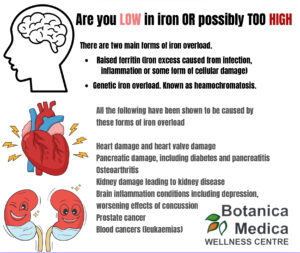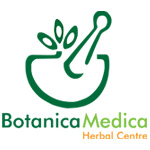
Whilst many people are aware of the signs and impacts of low iron, few people are aware of the problems of iron being too high.
It is one of the most under diagnosed nutritional problems I see with clients, and often overlooked medically.
There are two main forms of iron overload.
1) Raised ferritin (Iron excess caused from infection, inflammation or some form of cellular damage). Unfortunately most pathology labs in Australia have not been in line with overseas pathology guidelines in highlighting excess above the 150 level (150 mcg/L)
2) Genetic iron overload. Known as heamochromatosis. This a genetic impairment in the intestinal management of iron absorption, leading to excessive iron absorption and carriage in blood. In an iron studies test, this will show as HIGH iron saturation ( above 30 in women, 35 in men) and usually HIGH ferritin. Whilst the most severe form is easily found, the less severe forms still can cause major health problems, over time. Especially if the iron saturation is consistently high.
This leads to iron being deposited in various tissues, causing oxidation and damage to the cells and tissues it is deposited in.
All the following have been shown to be caused by these forms of iron overload
– Heart damage and heart valve damage
– Pancreatic damage, including diabetes and pancreatitis
– Osteoarthritis
– Kidney damage leading to kidney disease
– Brain inflammation conditions including depression, worsening effects of concussion
– Prostate cancer
– Blood cancers (leukaemias)
One reason that it is often overlooked, is that it often doesn’t show in women , until menopause, once a womens menstrual cycle has ceased.
This is why I screen most clients for iron, not just looking for low iron, but high.
Whilst the signs of low iron are obvious (tiredness, anaemia, pallor, lack of attention and focus, depression), the signs of high iron are less so, and much more diverse.
This form of high iron can be effectively treated, and result in improvement of the many conditions it can cause. These include, but is not limited to –
- Reducing iron intake ( red meat and organ foods; liver and kidney)
- Drinking black and green teas with high iron foods
- Donating blood
Different herbs in food and supplements can reduce this high iron absorption and reverse the damage caused by high iron.
Many people ask what do I do as a naturopath. A cornerstone of my approach is looking for these known, but often overlooked signs and casuses of illness and disease. Iron overload is a very good example of this.
If you would like to book an appointment with one of our Naturopaths at Botanica Medica please
call 08 8271-1827, we are located at 97-99 Glen Osmond Road, Eastwood SA 5063

Recent Comments